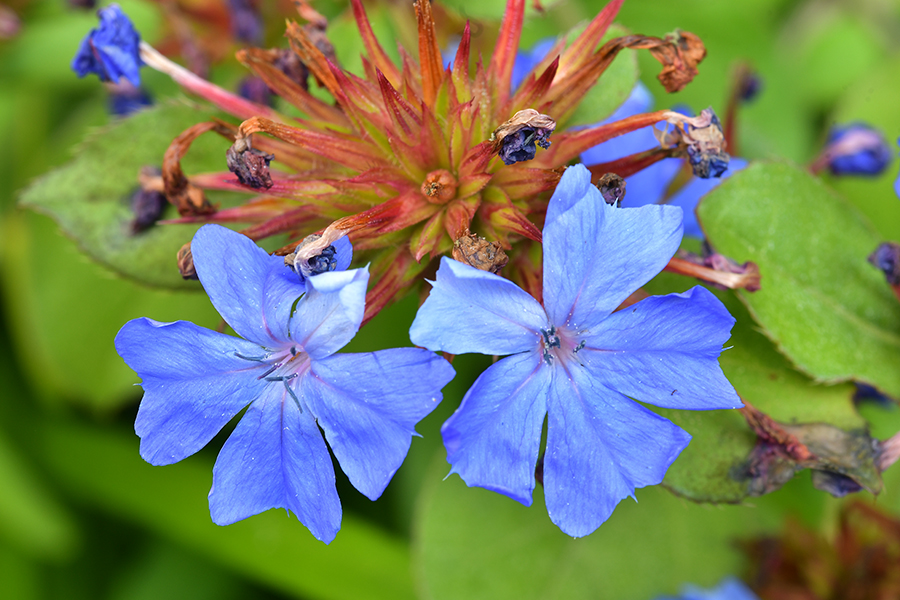I am a huge proponent of ground covers. They are very practical plants providing color and texture for the ground plan while also helping to reduce weeding – an attribute every gardener can appreciate! Surprisingly, or at least so to me, there appears to be a diminished interest in groundcovers with more homeowners preferring mulch over plants. Although mulch is beneficial, the beauty and benefits of a green cover interspersed with flowers cannot be outdone! Plants that add a lengthy floral display are certainly a bonus and few can compete with the colorful 5-month display provided by Ceratostigma plumbaginoides, commonly called Plumbago or Leadwort (as seen on the corner with Daylilies and Gardeners Garters in Picture 1).
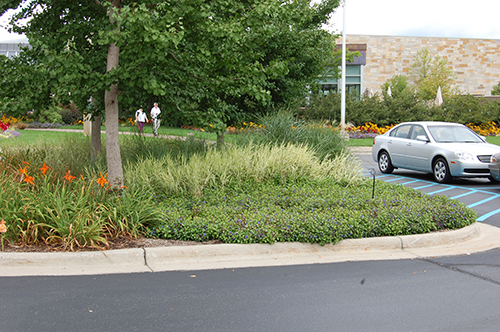
Ceratostigma is a member of the Plumbaginaceae, commonly known as the Plumbago or Leadwort family. The genus contains eight species native to tropical and temperate regions of Asia and Africa. The plants vary from herbaceous to woody subshrubs to shrubs. The common and family names reference how the deep blue flowers resemble the color of lead, as Plumbum (Pb on the periodic table) is Latin for Lead. Equally as intriguing is the story of its botanical name, as it is nearly novel worthy in length! The genus as well as the species name were initially crafted in 1833 by the Russian botanist Alexander von Bunge (1803–1890). Bunge had an incredible interest in botanical expeditions throughout his life and during the winter of 1830–31 he visited Peking China (now Beijing), where he found this botanically unnamed plant growing in a wall. The genus name came from combining the Greek Kéras meaning horn with the botanical term stigma, which is the sticky tip of the female pistil that receives pollen. The name stemmed from the minute, horn-like swellings on the stigma that require a strong magnifying glass to see. The species epithet means it resembles the genus Plumbago. Of course, the story simply could not be that short nor simple.

Since news often traveled slowly during this period in time, it was not unusual for a plant to develop several botanical names. A merchant trader known by the name of Mr. Smith found another specimen of Plumbago around 1846 growing in the city wall in Shanghai and successfully brought it back to England where it found a home in the garden of Sir George Larpent (1786–1855), a British businessman. Larpent was involved with trade from India and China, explaining his connections with traders. His wife, Lady Larpent was a well-recognized gardener and was the first to both successfully grow and quickly coerce the plant into bloom. It was subsequently described in 1847 by the British botanist John Lindley (1799–1865) as Plumbago larpentae and became commonly known as Lady Larpent Leadwort!
For the next chapter of the story, the focus moves to Ethiopia, known during the 1800's as Abyssinia. Henry Salt (1780–1827) was an Egyptologist who studied the language, traditions and architecture of Ancient Egypt. He collected a shrubby plant in 1809/10 that ultimately became known as Ceratostigma abyssinicum. However, in 1842, the German botanist and minister Christian Ferdinand Friedrich Hochester (1787–1865) named it Valoradia patula, with the genus name perhaps honoring a botanist and a new genus name for this group of plants was born! Aside from being a woody plant, one of the other distinctions was how the swellings or glands on the stigma are sessile or lacking a stalk, unlike the horn-like stalked projections of the plant Bunge had named! Shortly thereafter and in a rather odd turn of nomenclature, the Swiss botanist Pierre Edmond Boissier (1810–1885) published an essay in 1848 on Plumbaginaceae wherein he noted that Ceratostigma plumbaginoides and Plumbago larpentae were actually one in the same plant. Sadly, he ignored Bunge's considerations for the name and renamed it Valoradia plumbaginoides.
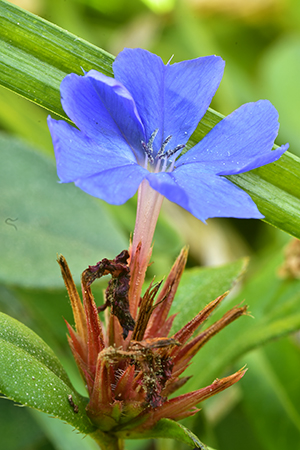
In the closing chapter we fast forward to 1906, when the Scottish Botanist Sir David Plain (1857–1944) wrote the essay 'The Genus Ceratostigma', in which he resurrected Alexander von Bunge's original name as the correct name. And just like that, the novel came full circle to a rather anticlimactic conclusion!
Fortunately, the plant is anything but anticlimactic. The plants spread by underground stems called rhizomes to slowly form a 5' diameter plant. The individual stems reach upwards of 10" tall (Picture 2), although some may collapse to the ground and create a matt-like appearance. The stems are clothed with 1–3" long, medium green and glossy foliage that is oval or egg-shaped (obovate). The tips of the stems contain clusters of 20–30 or more flower buds, which provide unabated gentian blue flowers from mid-July to a hard frost. The 1" diameter flowers are 5-petaled, with each petal appearing much like the tip was cut off by a pair of scissors, a shape botanically known as obdeltate! The center of the flower displays 4, spear-like dark blue anthers (as seen in Picture 3)) and a well-branched white female style that supports the pollen receiving stigmas on the apical tips.
Interestingly, Ceratostigma embodies the physically variable trait of Heterostyly. Such plants have styles and their male counterparts, the anther supporting filaments that vary in length based upon the individual plant. For those plants with long filaments yielding noticeable anthers, the stigmas and supporting styles are short. As you may have guessed, those plants presenting tall styles with projecting stigmas have short and barely noticeable anthers. This trait developed as a mechanism to prevent self-pollination. In Picture 3, the anthers are clearly seen, yet the style and stigma are hidden from sight! Heterostylous plants are designed for the pollen from plants with projecting stamens to be transferred to plants with projecting stigmas and vice versa based upon different sized pollinators or in some cases the same pollinator, but the pollen is simply carried on different parts of its body. This also explains why seedlings of Leadwort are rarely seen since the plants are often mass propagated from genetically identical stock plants, providing no variation within a planting. Although the plants are well-visited by a variety of pollinators, including hawk moths, without the ability to pollinate they are unable to produce seed.
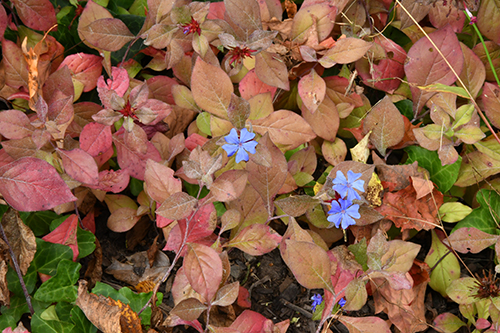
Each flower is subtended by a lance shaped leafy bract, which initially covers the flower bud before it opens. It also remains intact following petal drop. As the season progresses, each remaining bract develops red margins while retaining a green center (easily seen in Picture 6). If there was merely one bract, the impact would not be noteworthy. However, as the cluster of bracts grows to 30 or possibly more, the effect is very attractive, especially as the blue flowers continue to unfurl. The impact only improves with the onset of fall as the foliage turns to a bright red (Picture 4). The flowers, although fewer in number during late fall, continue to open and the overall impact is quite stunning. With the onset of heavy frosts, the foliage turns brown and drops, marking the end to the season's show.
The wiry leafless stems remain throughout the winter and new growth does not emerge from the ground until mid-May. The stems can be cut back through the use of a lawn mower or string trimmer, but it really is not necessary unless the plants are in a highly prominent area. With the relatively late emergence of the new growth, the plants are perfect for interplanting with early blooming minor bulbs, such as Snowdrops (Galanthus nivalis) or Bieberstein's Crocus (Crocus tommasinianus).
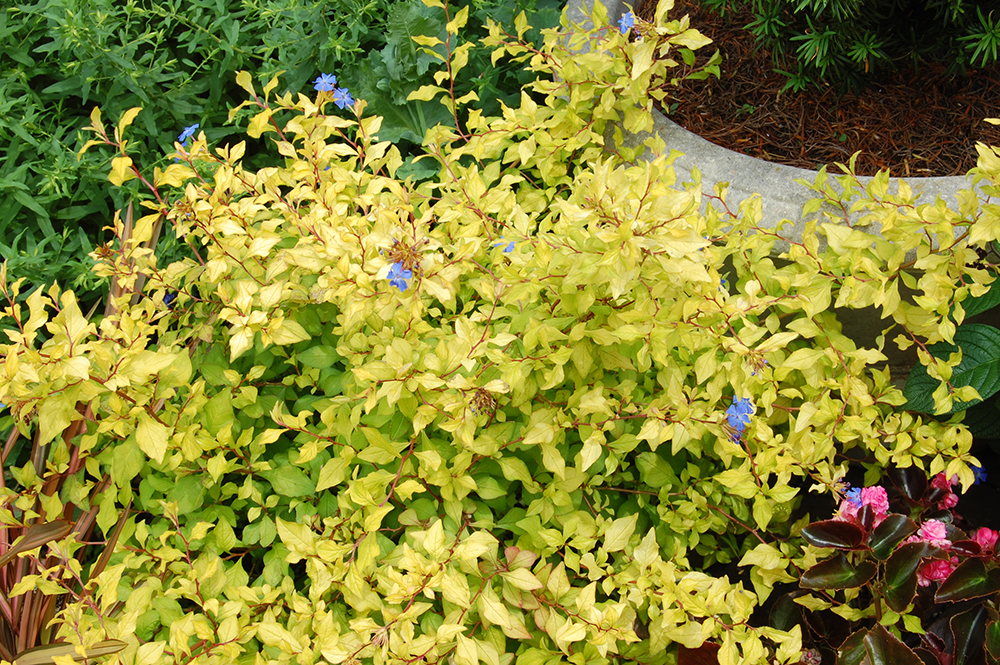
Plumbago is an easily grown plant that performs well in full sun or dappled shade, although it will not tolerate heavy shade. It is tolerant of sandy as well as heavier soils, providing the area is not prone to becoming waterlogged. In Asia, it is commonly found growing in rocky and well-drained regions as well as stone walls. Although each plant can slowly expand to 5' across, they are best planted 1' apart when used as a groundcover to expediate the process. The plants are also great for edging walkways and are unaffected by piles of shoveled snow, providing the soils are well-drained. Hardy in zones 5–9, the only objectionable quality for some gardeners is the lack of uniformity of habit when used in large masses. As mentioned, some of the stems collapse and lie closer to the ground while others remain upright, giving the mass a billowy appearance. Unlike many popular plants in commerce, only one yellow foliaged cultivar named 'My Love' is readily available in the trade (Picture 5). It is a slightly slower growing plant and is best used as an accent in the garden or in containers. It appreciates a little more shade than the species, although I have seen it growing happily in containers in full sun.
In an age when the term of sustainability is repeatedly mentioned in everyday life, it only makes sense for groundcovers to become a more common element in the garden. They provide a host of sustainable advantages, including reduced mulching, weeding and even prevent soil erosion! Although the name of Ceratostigma plumbaginoides took years to resolve, you only need to grow it for a few months to appreciate the many benefits it brings to the garden. Once again proving practical plants can be beautiful plants!
